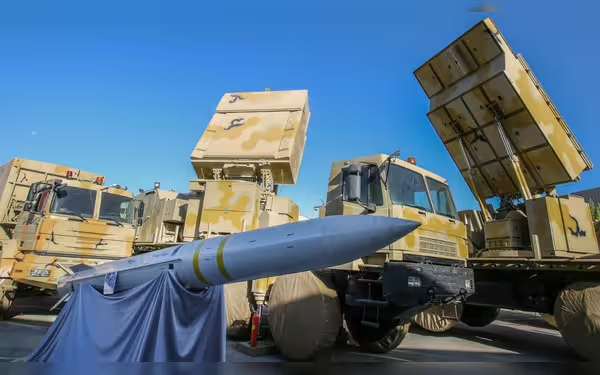Saturday, October 5, 2024 10:27 PM
Iran's Advanced Missile Capabilities and Regional Implications
- Iran possesses the largest stockpile of ballistic missiles in the Middle East.
- Missiles like 'Sejil' can reach speeds over 17,000 km/h.
- Iran's missile program is influenced by North Korean and Russian designs.
 Image Credits: arabnewspk
Image Credits: arabnewspkIran's missile capabilities raise concerns for regional security, showcasing advanced technology and geopolitical implications.
In recent years, Iran has significantly developed its missile capabilities, raising concerns among Western nations and regional adversaries alike. The country has demonstrated its ability to launch ballistic missiles, which are crucial for its defense strategy and deterrence posture against perceived threats, particularly from the United States and Israel. This article delves into the specifics of Iran's missile arsenal, its implications for regional security, and the ongoing geopolitical tensions.
On a notable occasion, Iran launched a series of ballistic missiles targeting Israel, marking a significant escalation in its military actions. This attack was a response to Israel's operations against Iran's allies, particularly Hezbollah in Lebanon. According to the U.S. Office of the Director of National Intelligence, Iran possesses the largest stockpile of ballistic missiles in the Middle East, which has been a source of concern for many nations.
Iran's missile capabilities include a variety of systems, with some missiles reportedly capable of reaching Israel. For instance, the 'Sejil' missile can travel at speeds exceeding 17,000 km/h and has a range of 2,500 km. Other notable missiles include the 'Kheibar' and 'Hajj Qasem', which have ranges of 2,000 km and 1,400 km, respectively. The Arms Control Association has identified several other missiles in Iran's arsenal, such as the 'Shahab-1', 'Zolfaghar', and 'Shahab-3', each with varying ranges that enhance Iran's strike capabilities.
Experts have noted that Iran employs both solid- and liquid-fueled missiles, with the former being more advanced and launched from mobile platforms. This versatility allows Iran to adapt its missile launches based on tactical needs. Furthermore, Iran has been developing underground missile depots and production facilities, which complicates efforts to monitor and counter its missile program.
In addition to ballistic missiles, Iran has also introduced hypersonic missiles, which can travel at speeds five times faster than sound, making them difficult to intercept. This advancement underscores Iran's commitment to enhancing its military capabilities, despite international scrutiny and sanctions.
Iran's missile program has drawn inspiration from North Korean and Russian designs, with assistance from China. This collaboration has enabled Iran to bolster its missile technology and expand its range of capabilities. Moreover, Iran has developed cruise missiles, such as the Kh-55, which can carry nuclear payloads and have a range of up to 3,000 km.
The regional implications of Iran's missile capabilities are profound. Iran's Revolutionary Guards have utilized missiles in various operations, including attacks on Israeli targets in Iraq and Syria. Additionally, Iran's support for groups like Hezbollah and the Houthis in Yemen has raised alarms, as these groups have also engaged in missile attacks against regional adversaries.
Iran's missile capabilities represent a significant factor in the ongoing geopolitical landscape of the Middle East. As tensions continue to rise, understanding the extent and implications of Iran's missile arsenal is crucial for regional stability. The international community must remain vigilant and engaged in dialogue to address the challenges posed by Iran's military advancements, ensuring that peace and security are prioritized in this volatile region.













